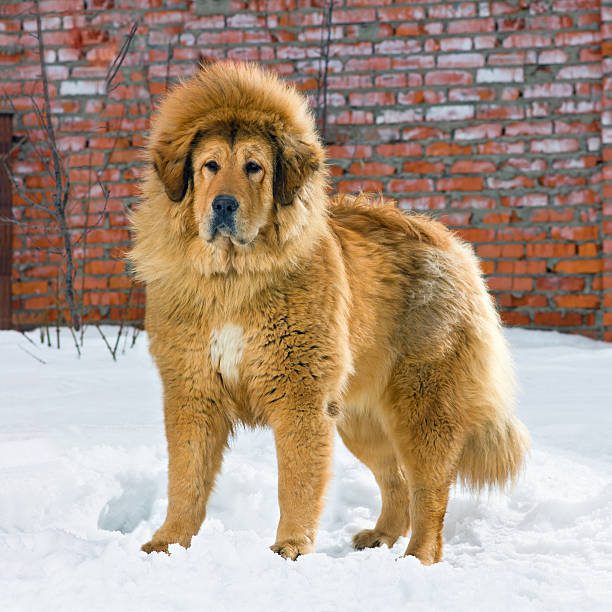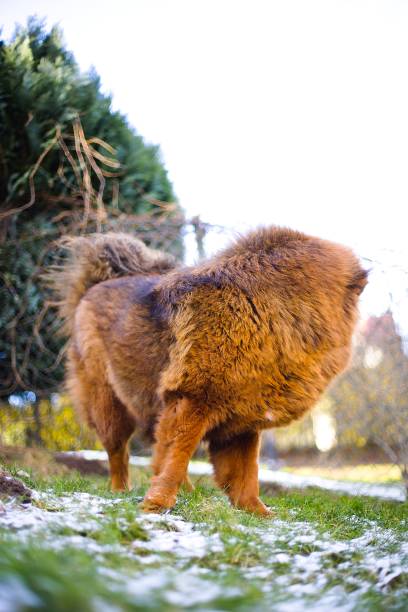Tibetan Mastiff one of the oldest and most cherished dog breeds in the world, a living legend clad in a lion’s mane and guardian of the Himalayas.

One of the oldest and most cherished dog breeds in the world, the Tibetan Mastiff is a living legend clad in a lion’s mane and a majestic guardian of the Himalayas. For centuries, monks, nomads, and emperors have accompanied these noble giants, whose presence is as commanding as the tall mountains they once guarded. More than just a dog, the Tibetan Mastiff is a symbol of strength, tradition, and wild beauty. It is fiercely loyal, incredibly intelligent, and enshrouded in myth. The term mastiff was assigned by the Europeans who first came to Tibet because that name was used to refer to nearly all large dog breeds in the West. Early Western visitors to Tibet misnamed several breeds, such as the Tibetan terrier, which is not a terrier, and the Tibetan spaniel, which is not a spaniel. A better name for the breed might be the Tibetan mountain dog.
Behind those watchful, soulful eyes is a breed as mysterious as the far-off places from which it comes. How did these canine giants transform from revered temple sentries to contemporary wonders? Why are they so difficult to own and so different? We explore some features of this breed’s companionship and protection.
Appearance

The Tibetan Mastiff, a dog that attracts attention not only for its size but also for its remarkable, almost legendary presence, is a magnificent combination of strength, grace, and primordial majesty. This breed’s ancient role as a protector of the Himalayas is reflected in every inch of its appearance, which combines regal beauty with tough functionality.
A Lion’s Mane and a Bear’s Build: A Bear’s Build and a Lion’s Mane
The Tibetan Mastiff, with its opulently thick double coat, initially looks like a lion crossed with a bear. The mane-like ruff of fur around their neck and shoulders, which gives them a lion-like silhouette, is their most recognizable characteristic. Jet black, deep blue (slate gray), fiery red, golden tan, or even a striking sable, frequently accentuated with rust or cream markings, are among the rich, earthy colors available for this thick, weatherproof coat. The fur on the neck, tail, and hindquarters is the longest, giving the animal a dramatic, flowing look that glistens when it moves. With a shoulder height of 26 to 30 inches (66–76 cm) and a weight of 100 to 150 pounds (45–68 kg), males are especially commanding.
The Head: A Fortress of Strength The broad, heavy, and raw-power-radiating head of the Tibetan Mastiff is a masterpiece of canine anatomy. Their muzzle is robust and square, terminating in a large, black nose, and their skull is enormous, with a noticeable stop (the dip between the forehead and muzzle). Their almond-shaped, deep-set eyes, which range in color from warm amber to dark brown, shine with intensity and intelligence. Although it is uncommon and frequently associated with particular coat colors, some dogs even have eye color that is strikingly blue or partially blue. They have triangular, medium-sized ears that sit high on the skull and are folded forward. They raise a little when they are on guard, which enhances their watchful demeanor. However, their jowls and dewlap, or loose throat skin, give them a somewhat frowning, “wise” look that makes them appear more formidable.
The Body: Built for Endurance. Under that opulent exterior is a strong, athletic body designed to survive the challenging terrain of the Himalayas. Their thick, arched neck flows into a deep, wide chest that can hold strong lungs for endurance at high altitudes. Their legs are strong and straight, ending in big, cat-like paws with thick pads for gripping icy ground, and their back is straight and strong, leading to a slightly sloping croup (rear). Tibetan Mastiffs move surprisingly gracefully and nimbly for their size. With a rolling, nearly bear-like stride that exudes strength and purpose, their gait is powerful and purposeful. Their thick tail, which is heavily feathered and plumed, curls over their back like a banner when they run, swaying in time with their movements.
The Coat: Armor Against the Elements The double coat of the Tibetan Mastiff is an amazing feat of natural engineering. The long, straight, coarse outer coat serves as a barrier against the elements, including rain, snow, and strong winds. It is protected from below-freezing temperatures by a thick, soft undercoat. This undercoat thickens significantly in the winter, making the dog appear larger and almost legendary. Different dogs have different coat textures; some have a “shawl” around their neck that is slightly wavy, while others have a more streamlined, straight appearance. Twice a year, the “blowing coat” occurs due to intense seasonal shedding, which necessitates careful grooming to control the fur avalanche.
Expression: The Eyes of a Guardian The penetrating, serene, and profoundly perceptive gaze of a Tibetan Mastiff is unforgettable. Their eyes, which exhibit a combination of independence, loyalty, and silent vigilance, appear to bear the weight of their long ancestry. They may seem almost calm when at ease, but the instant they perceive danger, their expression changes to one of concentrated intensity, and their body stiffens like a spring.
The Tibetan Mastiff as a Companion & Protector

Not just a pet, the Tibetan Mastiff is a fiercely loyal family member, a sovereign guardian, and a living example of the relationship between people and dogs. A gentle giant with loved ones and an unwavering sentinel against threats, this breed was bred for millennia to defend livestock, monasteries, and nomadic tribes in the harsh Himalayas. However, what does living with a Tibetan Mastiff actually entail? Let’s examine the intricacies of their relationship and their unmatched protective tendencies.
The Protector: A Born Guardian Tibetan Mastiffs have been used for centuries to protect flocks from Himalayan bears, wolves, and leopards. Their innate courage, territoriality, and vigilance have been refined by this role. The Tibetan Mastiff’s protective instincts are natural and self-directed, in contrast to breeds trained for protection work. They evaluate threats on their own and take decisive action without waiting for orders. Territorial Mastery: They consider their family and home to be their territory. Both human and animal intruders are greeted by a powerful physical presence and a deep, thunderous bark that can be heard for miles. Distinguishing Judgment: They do not act aggressively without cause. Rather, they scrutinize strangers closely and only trust people who are accepted by their family. Night Watchmen: Many Tibetan Mastiffs are nocturnally vigilant and patrol their territory long after their family has gone to bed. Historically, they have done so while it was dark.
The Companion: Loyalty Rooted in Respect Tibetan Mastiffs develop close, almost reverent, ties with their families despite their intense protectiveness. But this loyalty is not bestowed freely; it must be earned. They provide a silent, unwavering devotion to people who value their independence rather than being “velcro dogs” in need of continual affection. Family-Centric: They do best in a quiet, orderly setting with distinct roles. They become kind, understanding, and incredibly affectionate with family members, especially the kids they grew up with, once they accept you as their leader. Independent Spirit: They don’t look for attention all the time. Rather, they would remain near, frequently arranging themselves in a space to examine every point of entry. Sensitivity to Energy: Highly attuned to their family’s emotions, they can sense stress or tension and may respond by standing closer or patrolling more intently.
Challenges of Companionship

A Breed That Requires Knowledge
Having a Tibetan Mastiff is not a hobby; it’s a lifestyle choice. Their savage nature and protective tendencies necessitate an owner who is experienced. They require a leader who is self-assured, reliable, and able to set limits without being harsh. Proactive in Socialization: To avoid overprotective or reactive behavior, early, constructive exposure to strangers, other animals, and diverse environments is essential. Respectful of Their Nature: Anxiety or defiance will result from attempts to repress their protective tendencies or impose an excessive amount of social interaction.
Accommodations
Space: Because they are expert climbers and diggers, they need a safe, roomy yard with high fences. Their needs are not well served by urban apartments. Climate: They are susceptible to overheating due to their thick coat. Temperature-controlled homes or cooler climates are ideal. Activity: They require moderate exercise and daily mental stimulation (puzzle toys, scent games) to avoid boredom, even though they are not hyperactive
Finding the Right Balance Between Protection and Overprotection
When a Tibetan Mastiff is mishandled, it can grow suspicious or domineering. Important techniques to constructively channel their instincts: Structured Training: Teach commands like “quiet” or “leave it” using methods that rely on rewards. Training that emphasizes aggression should be avoided as it intensifies their innate intensity. Allow them to patrol and bark at newcomers as part of controlled guarding, but teach them to back off as soon as a threat has been eliminated. Socialization Rituals: To reinforce that not all strangers are dangerous, invite trusted guests over on a regular basis and reward composure.

Conclusion
A Tibetan Mastiff is more than just a pet; it’s a living legend, a four-dimensional protector whose devotion is as profound as the height of the Himalayas. This breed isn’t for the timid or the occasional dog owner. It requires tolerance, deference, and an awareness that this dog’s instincts have been molded by centuries of solitary existence, snowfall, and sacred duty. However, the rewards are incalculable for those who take on the challenge. Imagine having a friend who watches over you while you sleep, whose devotion is as unwavering as the mountains they used to roam, and whose very presence inspires reverence. In addition to sharing your house, a Tibetan Mastiff guards your heritage by keeping watch over it. However, be advised that this dog will not survive solely on your approval. It is not a servant; it is a partner. It will put you to the test, push you, and require your leadership. In exchange, it will provide a love that is earned rather than given freely; it is based on trust between people and innate instincts. So, consider this: Are you brave enough to confront this noble beast as it is? If so, you might have the most devoted, amazing dog in the world—a real king among dogs, whose heart beats in time with Tibet’s untamed, wild spirit.The question remains: Are you worthy of such a guardian?

best information about this breeds